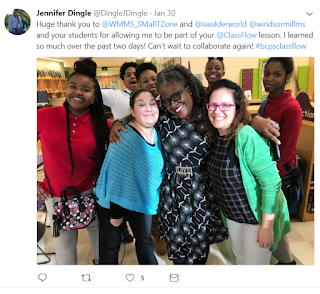Who knew that a tweet would lead me to step out of my comfort zone?
Anyone who knows me, realizes I tend to be a creature of habit. I also don't like to do something that I am not "good at." ClassFlow was that something. Reintroduced to it in August during a library media specialist professional development, I was intrigued by the tools that were offered. From collaboration to individual assessment, it seemed to have everything I was looking for in an online resource. A week or so later, I tried to recreate a chart I could use with students during their library orientation. For whatever reason, I couldn't figure out how to create the charts I had envisioned in my head. The unfamiliarity led me to put ClassFlow on the shelf. I changed my mind when I saw a Tweet.
The Tweet that started it all
I was intrigued and contacted Jennifer Dingle to set-up a session. Immediately, I was put at ease by her jovial manner. No question was too embarrassing to ask and many of my ideas were exciting to her. I shared with her that I wanted to use the tool for a lesson that was a week away. A daunting task considering the lesson I envisioned required use of tools and tricks that veteran ClassFlow users tended to use, Ms. Dingle encouraged me to try it out and told me the steps I would have to complete. We set-up another date and time for a follow-up meeting to check my progress.
 |
Planning was keyLong evenings at the school were my time to focus on the lesson and create the charts I wanted based on the notes and directions provided by Mrs. Dingle. The next few evenings reminded me of my first year as a teacher in Baltimore County Public School Systems. Quite a bit of work was required to create slides students could edit as a group, as well as slides which linked students to Flocabulary videos related to a test taking strategy assigned to the group. Realizing that some of the lesson needed to streamlined, I asked for the input of the classroom teacher I would present the lesson within the next week. Mrs, Walder provided me with a list of nine literary topics that the students needed to focus on (text structure, summarizing, inferencing, etc.). One more planning session with Jennifer Dingle, and I was ready to present the lesson to the class.Placed in groups by their classroom teacher, students were given the task to watch a Flocabulary video and create a presentation for their peers. The presentations had to include two or more tips , an example the audience could try to answer, and the answer with an explanation. Working collaboratively with their peers on charts, students assigned roles to members within their groups and began to work on the presentation using ClassFlow. For many of the classes, this was their first time using ClassFlow.
 Thanks to a tweet, I was able to try a new technological tool, collaborate with a new partner, and enhance a lesson. I am so grateful I saw that Tweet and I am grateful I was able to enhance the learner centered environment in the library. Using ClassFlow was a wonderful way to engage the students and add rigor to the lesson. |





No comments:
Post a Comment